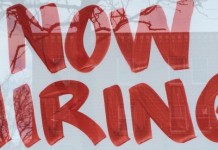“More jobs” has been the rallying cry since at least 2008. The cry continued unabated through eight years of slow but steady job growth. And “more jobs” continues to be the cry although we’re still at a 16-year low of 4.3 percent unemployment.
May job increases weren’t up to snuff–just 138,000 jobs were added. That’s likely to raise the “more jobs” pitch a few more decibels. But “more jobs” isn’t just an outdated message–it’s now a destructive message.
A recent AP story spells it out: Unemployment is at a low point. But job openings are at an all-time high. The disappointing May job numbers reflect the fact that “‘…businesses are struggling to fill these positions,’ said Beth Ann Bovino, U.S. chief economist for S&P Global Ratings.”
5.0 Is “Full Employment”
Putting things in perspective, the Federal Reserve considers 5.0-5.2 percent unemployment to be “full employment.” no matter how robust the economy, there will always be companies going out of business. Companies reorganize, hiring some folks while they lay off others. People re-enter the job market after time off for family or education or health reasons.
In addition, employment statistics are a nationwide average. You know the old joke about averages. If you have one foot in the freezer and the other foot on a hot stove, the temperature underfoot is about average.
According to the New York Times, “Nearly a third of the 388 metropolitan areas tracked by the Bureau of Labor Statistics have an unemployment rate below 4 percent, well below the level that economists consider ‘full employment,’ the normal churn of people quitting to find new jobs. The rate in some cities, like Ames, Iowa, and Boulder, Colo., is even lower, at 2 percent.”
That is, of course, small comfort to people in rural areas where unemployment is still high. Many areas are untouched by the tech boom that fuels employment in Ames and Boulder. For those people, unemployment and underemployment persist. Their stories continue to be offered up anecdotally to show why “more jobs” is the answer.
Their pain is real. But as Abraham Maslow (among others) said: “I suppose it is tempting, if the only tool you have is a hammer, to treat everything as if it were a nail.” Pounding away at the “more jobs” message has proven successful politically. As long as the anecdotes of the under-employed and unemployed exist–and they always will–there is no shortage of nails.
“More Jobs” Is an Irresponsible Message
But that message is irresponsible, and it has to stop. We need to start shouting “more workers!” When we finally see that “more workers” is the problem, we will also see the need for better access to affordable education. We’ll see that our immigration policies need to admit more workers with the skills we need–from picking fruit to performing surgery.
Those public policy changes will make the switch from “more jobs” to “more workers.” The workers themselves need to realize that times change, and continue to change. There have been Great Migrations in the past–from the Dust Bowl to California, from the Deep South to the great manufacturing centers like Pittsburgh and Detroit. Now, perhaps, people will need to leave Pittsburgh and Detroit to go to Ames and Boulder.
Finally, as economists Andrew Weaver and Paul Osterman have noted, employers need to realize that it’s time to update their recession-era practices. They can’t keep expecting workers to do two jobs for one wage. They can’t keep “looking for hyperspecific skills that few outside workers could be expected to have.” They have to take responsibility for turning the workers available into the workers they need. “Companies,” Weaver and Osterman wrote, “are unwilling or unable to solve their skill challenges through internal training, even for skills that are highly specific to a particular plant.”
“More workers” is the rallying cry for economic growth. “More jobs” is only going to stifle our economy.











